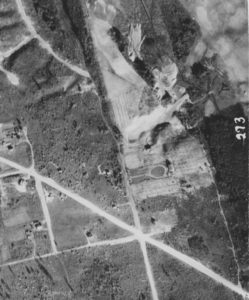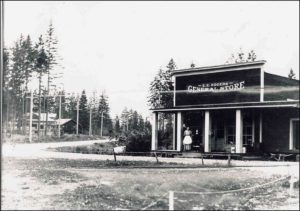Heritage Highlight April 2015:
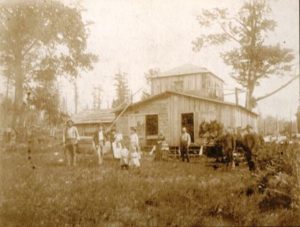
The Holloways arrived in Richmond Beach in February of 1889. They had followed Sadie Holloway’s parents, the Conway Thompsons, who arrived earlier and put down a homestead claim near what would become 8th NW. The Thompsons did not have room for many people in their small place, however, so John T. and Sadie Holloway, with two small girls in tow, were forced to find lodging elsewhere. An abandoned cabin on the beach, now the location of “Apple Tree Lane,” seemed to fit the bill, and the family took up residence there. They were not the only ones in the family to make the trip out west that winter – J.T. Holloway’s parents, the Martin Holloways, had accompanied the younger couple as well, and most likely stayed with them in the cabin.
It was thought to be a smuggler’s cabin, evidenced by the “widow walk” around the turret-like upper story for spotting delivery boats, and the many hiding places that were found inside the cabin walls and floors. Opium smuggling was a big business at that time, and is quite likely that the cabin was built there for that purpose, and without the property owner’s permission. In October of 1889, Lena Holloway was born. She is pictured in a highchair sitting in front of a woman who is possibly her mother Sadie, who is standing closest to the cabin.
Throw-Back Thursday February 12th:
The year was 1939, and the Works Progress Administration, or WPA, was still in full swing. In simplified terms, the WPA was a Federal program that had been created to help people keep working through the Great Depression. Communities or organizations would hire the WPA to accomplish a project that needed doing, and the community would share a portion of the cost, with the WPA subsidizing part of it. Many projects were completed across the country, including several in Northwest King county. The photo shows the building of the retaining wall at the east side of the Richmond Beach school property along 21st Avenue NW. Today, the wall remains a stalwart part of the property where the Richmond Beach library is located.
Throw-Back Thursday January 29th:
You’d never recognize it now, but these young men on horseback, ca 1925, are posing right about where the south side of the Shoreline Costco is today. Herbert Butzke, far left, was from Hawaii and was the nephew of Herman and Minnie Butzke who owned and operated the Echo Lake Bathing Beach. The other riders, Rush Moulton and Twin Benson, were local boys that Herbert knew, as he visited the area often. The photographer, probably Herbert’s cousin Florence Butzke, has her back toward 200th Street. The Robinsons raised thoroughbred race horses for several years on their property which would eventually become Aurora Village. Their son, Nat Robinson, attended Ronald School.
Throw-Back Thursday January 22nd:

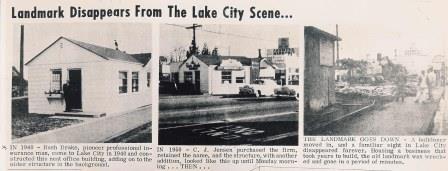
If you go to work or school using Lake City Way every day, you probably drive by this building at the southeast corner of Lake City Way and 125th. For many years, the side of the building proclaimed “Rush Drake Insurance” and the logo was a stylized pond with cattails and a duck. You probably never even gave a thought as to how this came about.
It’s quite possible that you didn’t even know that “Rush Drake” was an actual person. He and his wife Barbara Lindblom Drake moved to Lake Forest Park in 1916. They had a daughter named Barbara Lindblom Drake Junior (really!) who became Barbara L. Drake Bender, the writer of “Growing Up with Lake Forest Park,” two incredible volumes of history. Daughter Barbara was also an artist and art teacher, and she invented the logo for Rush Drake insurance – a picture of “rushes” (the cattails) and the “drake” (a male duck). After working for other since 1919, Rush Drake finally opened his own in 1942 in the small house-converted-to-office building seen in the upper left corner of the article. In 1950, Drake’s partner, Cornelius “Corny” Jenkins bought the business but kept the name, which was synonymous with honesty and quality customer. The little building was eventually replaced by the modern structure in 1965, which remains today. The logo is a little different, but the current owner of the company still uses a stylized flying duck!
Your Heritage Highlight and Throw-back Thursday for January 15:
Morton was born in Norway around 1842 and immigrated to the United States with his wife Johanna in 1870. Johnanna passed away in 1895, just as Morton was returning to their home in Artichoke Lake Minnesota from an adventuring trip to the Pacific Northwest. Perhaps he had dreams of moving to Puget Sound with her, but that was not to be. In 1901, Morton left Artichoke Lake Minnesota for good, and came to Richmond Beach. He chose 27 acres on the east side of 15th Avenue NW, at what would become NW 200th St. Other family members joined him here, and they built the large farm house seen in the photo, taken around 1905. Strawberries were the crop of choice for nearly everyone in Richmond Beach, and so the Andersons grew strawberries too, with the fields surrounding the house front, sides and back. Family members and other pickers stand with their berry flats in hand.
THROW-BACK-THURSDAY January 8, 1926 – see newspaper article below!
Do you long for the days when the station dogs greeted you when you stepped out of the car? And then you chewed the fat with the owner while he pumped your gas and ckecked your oil? Thor Thorsen’s place was that kind of station. Built in 1916 when Thor was in his early 20′s, it was on the southwest corner of what is today 185th and Aurora. Back then, 185th was just a dirt road, and Aurora didn’t exist. Instead, there was the North Trunk Road, a two-lane brick affair that angled up Firland’s Way (yes, the apostrophe is correct!) and then back down at Echo Lake. The Yost made Thorsen’s a central stopping point for the Richmond Highlands area, dropping off going to staff Firland Sanatorium, and picking up workers to go to downtown Seattle. Thor’s corner was very wi-i-i-i-de, so when Highway 99 was executed, Thor was able to keep some of the corner and the station.
Throwback Thursday January 1th:
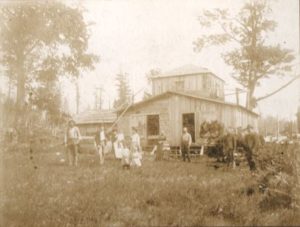
The John T. Holloway family poses for a picture in late1889, in front of the abandoned smuggler’s cabin they found near the beach in what would become the town of Richmond Beach.
When the Holloways arrived in what would come to be known as Richmond Beach, only their in-laws and a couple of other families were there, according to Lena Holloway Vories, who was born in Richmond Beach in 1889 in the building shown in the picture. John T. and Sadie Holloway knew they could not live with her parents in their small place, so they took over an abandoned cabin on the beach, where later John Lindsay would have his boat house. The cabin had been built by smugglers, and was equipped with hidden panels and moving floor boards inside, and a “widow’s walk” for spotting the arrival of boats and signaling partners in crime. The widow’s walk can be clearly seen in the photo. The smuggling of opium from Canada down the coast of Puget Sound to Seattle was a lucrative business during the late 1800′s. Smugglers preferred to operate in unpopulated areas from which to move their shipments, and, as is the case in Richmond Beach, would actually build structures near the beach without the knowledge of legal . If they were , or if people began to populate the area, the smugglers would just move on to a more secluded area.
HERITAGE HIGHLIGHT FOR NOVEMBER 2014:
You’re looking at a 1929 aerial of the triple intersection at Ne 130th St., 5th Ave NE, and Roosevelt Way (the angle street.) About one year prior to the opening of Jackson Park Course (May of 1930), James W. and Sara Mae Higgins built their magnificent manor house on the luxurious acreage immediately south of the golf course. Circular driveway, sprouting orchard, and wooded glens spanned from 5th to 10th, and from the golf course to 130th. The house still stands today as the parsonage for the North Seattle Church of the Nazarene, and is a 2014 Trillium Heritage Award ! See our Awards page for a photo of each of the structures and more info!
HERITAGE HIGHLIGHT FOR SEPTEMBER 2014:
You’re looking at the Ronald Bog peat mining operation in 1960. The photographer back is looking southwest at Meridian Avenue and Cordell Hull Middle School in the distance on the left, and Meridian Park grade school in the distance at the center of the picture. 175th Street is behind the photographer; George Webster is on the tractor, and the bog waterway is just visible beyond the tractor. Mining of the peat began in the 1940s, and through the 1960s.
The bog is a natural formation of layers and layers of peat that once supported an ecosystem that included wild cranberries. Duwamish people from the permanent settlements beside Lake Washington, Lake Union and Salmon Bay, and other tribes visiting from Snohomish county, came to the bog to harvest the cranberries and other edible plants that grew there. The bog was also a central stopover place on the portage route from Lake Washington to Puget Sound.
You’re looking at the Ronald Bog peat mining operation in 1960. The photographer back is looking southwest at Meridian Avenue and Cordell Hull Middle School in the distance on the left, and Meridian Park grade school in the distance at the center of the picture. 175th Street is behind the photographer; George Webster is on the tractor, and the bog waterway is just visible beyond the tractor. Mining of the peat began in the 1940s, and through the 1960s.
The bog is a natural formation of layers and layers of peat that once supported an ecosystem that included wild cranberries. Duwamish people from the permanent settlements beside Lake Washington, Lake Union and Salmon Bay, and other tribes visiting from Snohomish county, came to the bog to harvest the cranberries and other edible plants that grew there. The bog was also a central stopover place on the portage route from Lake Washington to Puget Sound.
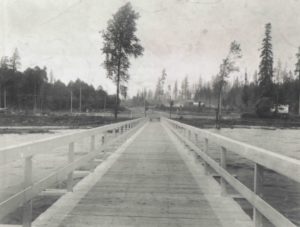
The Lake Forest Park Mosquito Fleet Pier, 1912
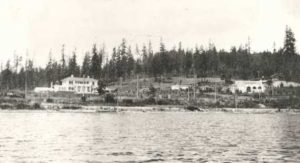
Wurdemann house. left, and Croxton Rion house, right, 1915
Lake Forest Park was just getting started when the photo on the left was taken, possibly by Asahel Curtis. The photographer is standing on the Mosquito Fleet Pier (the forerunner of today’s ferry system), looking back at what would become the intersection of Bothell Way and Ballinger Way. Paving work is just being done on the Gehr Erickson (Bothell Way) road. In just two years, the scene would change to include several homes, one of which would stand exactly where the little North Seattle Improvement Company Real Estate office is, off in the distance in the next photo. That home is the Wurdemann mansion, which still stands today. You can take a private tour of this beautiful mansion and grounds at 6:00 pm on may 20th – click here for details and tickets.
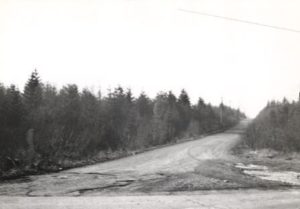
Greenwood and Innis Arden Way, 1954
Although the Innis Arden development was hot property by 1954, the infrastructure had not yet caught up. Model homes were featured in Sunset Magazine, but they failed to mention needing all-terrain tires on your car, and mud boots on your feet in order to reach the area. The road actually cut through what would later become the Shoreline Community College campus and had to be moved in order for the campus to be all one. undivided piece of property. Ray Howard and Fran Holman negotiated with the Boeing estate to purchase the property for the school district.
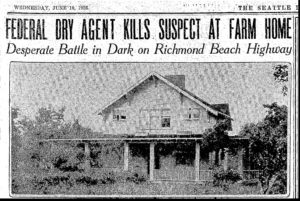
1925 Seattle Times image of the Richmond Beach property where a still was being run in the barn “out back” of the house
The house was located at the southeast corner of 8th NW and NW Richmond Beach Road, where today stands a “Rite Aid” drug store, which used to be a Tradewell Grocery store. John Lusk, a bootlegger, was running a still in the barn, apparently unbeknownst to the owners of the farm. They appeared to be quite puzzled upon learning of Mr. Lusk’s real chosen profession.

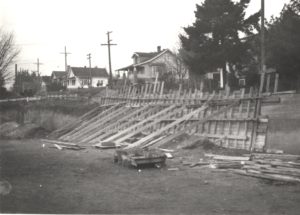




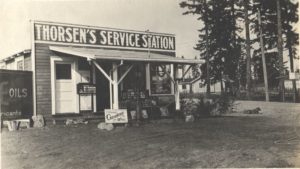
 The John T. Holloway family poses for a picture in late1889, in front of the abandoned smuggler’s cabin they found near the beach in what would become the town of Richmond Beach.
The John T. Holloway family poses for a picture in late1889, in front of the abandoned smuggler’s cabin they found near the beach in what would become the town of Richmond Beach.